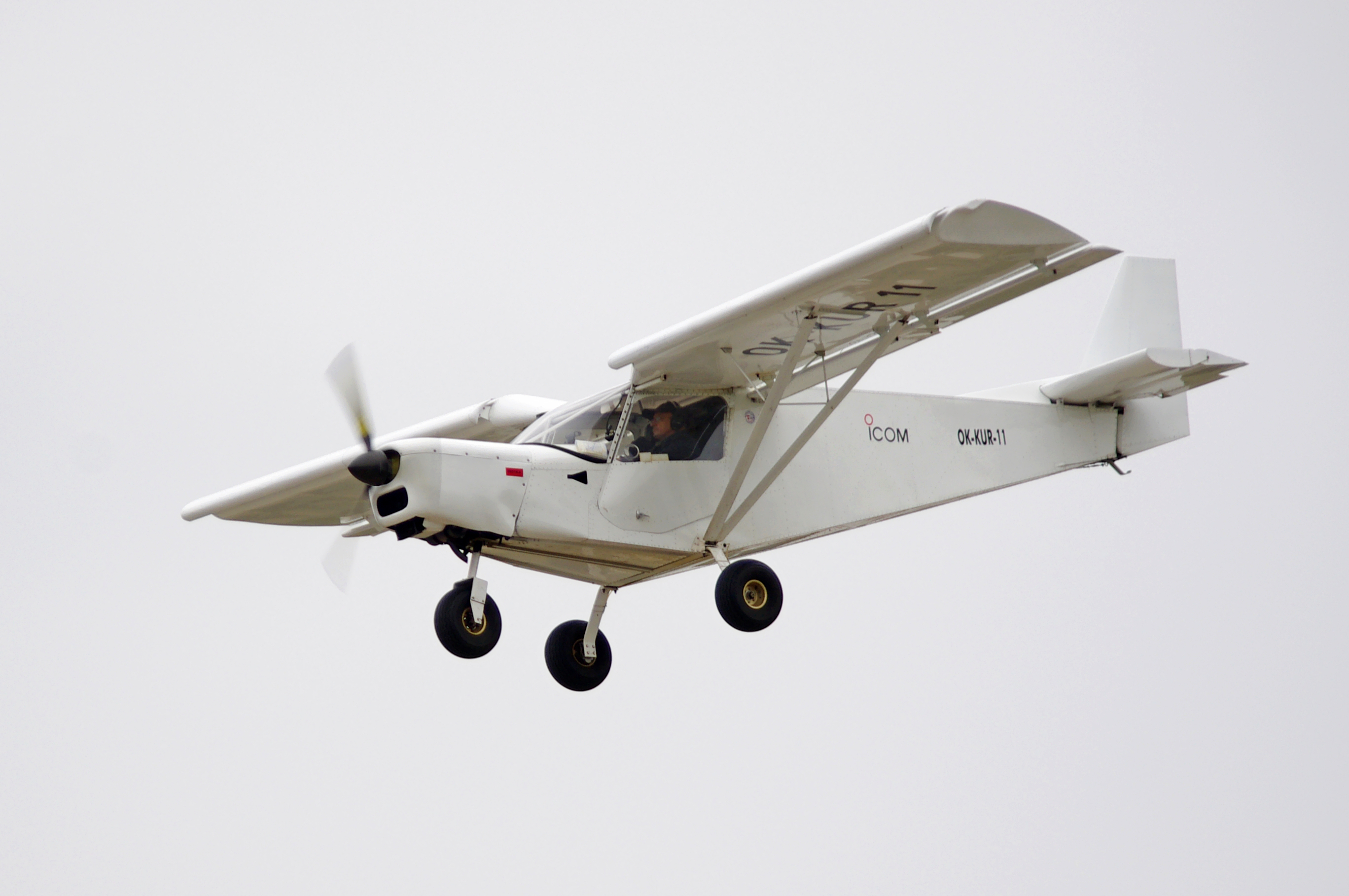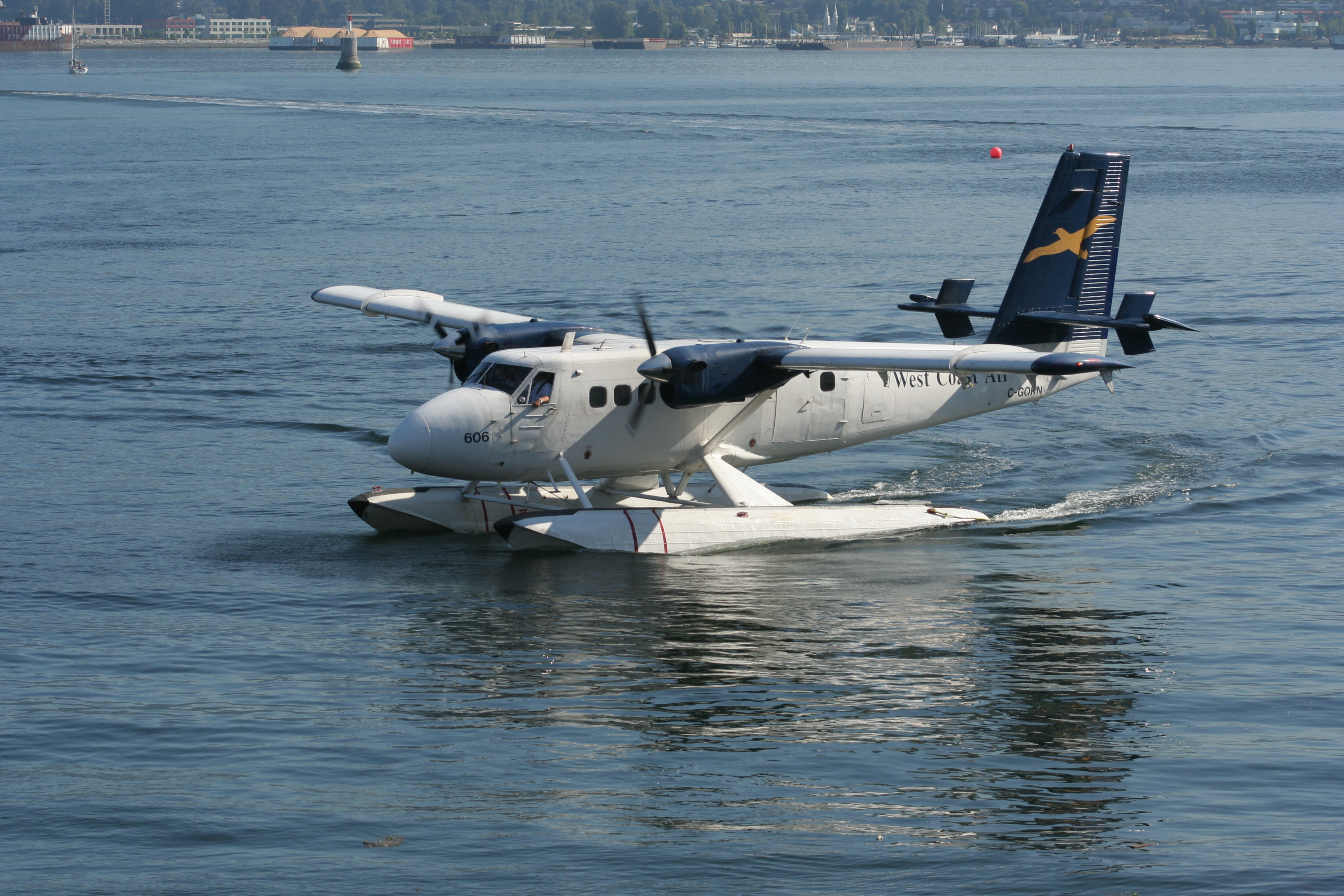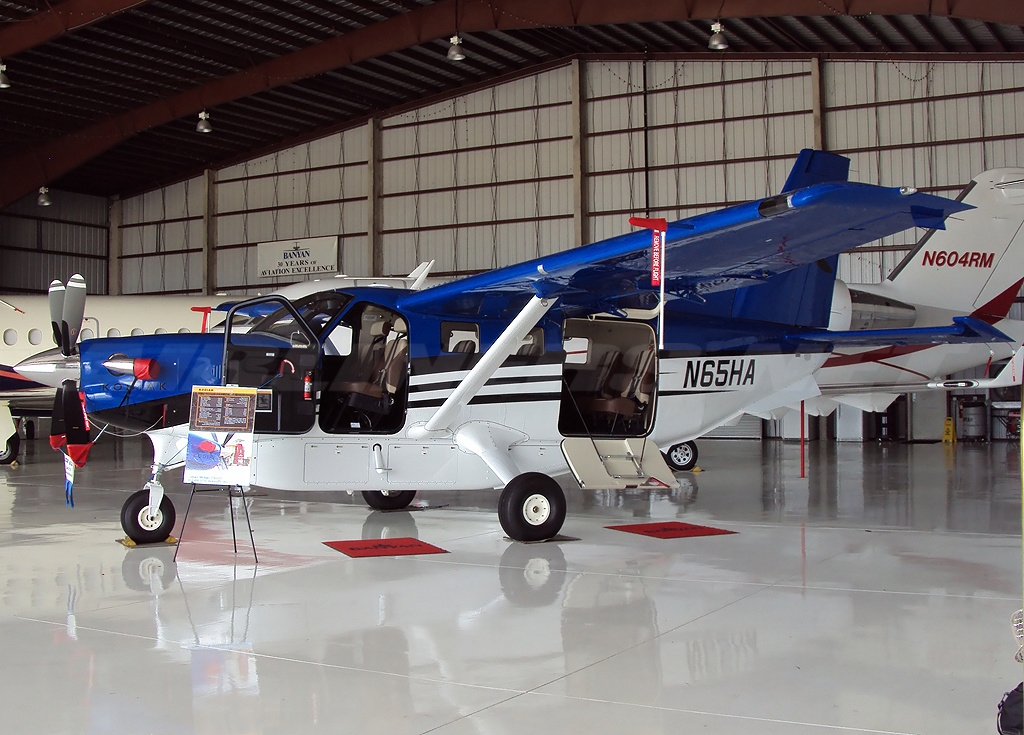|
STOL
A short takeoff and landing (STOL) aircraft is a fixed-wing aircraft that can takeoff/land on short runways. Many STOL-designed aircraft can operate on airstrips with harsh conditions (such as high altitude or ice). STOL aircraft, including those used in scheduled passenger airline operations, can be operated from STOLport airfields that feature short runways. Design STOL aircraft come in configurations such as bush planes, autogyros, and Conventional landing gear, taildraggers, and those such as the de Havilland Canada Dash-7 that are designed for use on conventional airstrips. The PAC P-750 XSTOL, the Daher Kodiak, the de Havilland Canada DHC-6 Twin Otter and the Wren 460 have STOL capability, needing a short ground roll to get airborne, but are capable of a near-zero ground roll when landing. For any plane, the required runway length is a function of the square of the stall speed (minimum flying speed), and much design effort is spent on minimizing this number. For take ... [...More Info...] [...Related Items...] OR: [Wikipedia] [Google] [Baidu] |
STOLport
A STOLport or STOLPORT was an airport designed with STOL (Short Take-Off and Landing) operations in mind, usually for an aircraft class of a certain weight and size. The term "STOLport" did not appear to be in common usage as of 2008, although was commonly used by pilots flying into Biggin Hill during 1986/87 when the London City Airport was opened restricting approaches and ceilings to the north of Biggin. A STOLport usually has a short single runway, generally shorter than . STOLports are only practicable by certain types of aircraft, especially smaller propeller aircraft, with performances that are compatible with the shorter runway length, steeper approach/departure paths, etc. at individual STOLports. In the United States, short runway facilities are simply known as airports, and the term "STOLport" has not been commonly used since the early 1970s. Definition The International Civil Aviation Organization (ICAO) defines STOLports as "unique airports designed to serve airpla ... [...More Info...] [...Related Items...] OR: [Wikipedia] [Google] [Baidu] |
De Havilland Canada DHC-6 Twin Otter
The de Havilland Canada DHC-6 Twin Otter is a Canadian STOL (Short Takeoff and Landing) utility aircraft developed by de Havilland Canada in the mid-1960s and still in production today. Built by De Havilland Canada from 1965 to 1988, Viking Air purchased the type certificate and restarted production in 2008, before re-adopting the DHC name in 2022. In 2023, DHC started production of the 300-G, an upgraded version of the Series 400 with Garmin avionics. The aircraft's fixed tricycle undercarriage, STOL capabilities, twin turboprop engines and high rate of climb have made it a successful commuter airliner, typically seating 18–20 passengers, as well as a cargo and medical evacuation aircraft. In addition, the Twin Otter has been popular with commercial skydiving operations, and is used by the United States Army Parachute Team and the 98th Flying Training Squadron of the United States Air Force. Design and development Development of the aircraft began in 1964, with th ... [...More Info...] [...Related Items...] OR: [Wikipedia] [Google] [Baidu] |
PAC P-750 XSTOL
The PAC P-750 XSTOL, (formerly known as the PAC 750XL) is a utility aircraft of conventional all-metal low-wing monoplane design, with fixed tricycle undercarriage. Combining the engine and wings of the PAC Cresco with a new larger fuselage and modified tail, all versions to date have been powered by a 750 hp (560 kW) Pratt & Whitney Canada PT6 turboprop. It is designed and manufactured in Hamilton, New Zealand, by Pacific Aerospace Limited. Development The design made its maiden flight in 2001. As with the Cresco, horizontal tail surfaces presented difficulties, and these were redesigned before the type entered production. The PAC 750 received full US FAA certification in 2004. In 2008, the manufacturer stated production was increasing from 12 to 24 per year. In 2008, there was some New Zealand media criticism of government assistance for the manufacturer following cancellation of a large order. By February 2016, 100 aircraft had been produced, over 120 by Jan ... [...More Info...] [...Related Items...] OR: [Wikipedia] [Google] [Baidu] |
Fieseler Storch (7582553016)
The Fieseler Fi 156 ''Storch'' (, "stork") is a liaison aircraft designed and produced by the German aircraft manufacturer Fieseler. Its nickname of '' Storch'' was derived from the lengthy legs of its main landing gear, which gave the aircraft a similar appearance to that of the long-legged, big-winged bird. Developed during the mid 1930s in response to a request from the Reichsluftfahrtministerium (''Reich Aviation Ministry'' or RLM), the Fi 156 was an affordable and easy to construct aircraft purpose designed for the liaison, army co-operation, and medical evacuation roles. On 24 May 1936, the Fi 156 V1 performed its maiden flight; the first deliveries took place less than a year later. It was well regarded for its excellent short field (STOL) performance and low stalling speed of 50 km/h (31 mph). Around 2,900 aircraft of various models, the most commonplace being the ''Fi 156C'', were produced between 1937 and 1945. The Fi 156 quickly became popular on the export market, ... [...More Info...] [...Related Items...] OR: [Wikipedia] [Google] [Baidu] |
De Havilland Canada Dash-7
The de Havilland Canada DHC-7, popularly known as the Dash 7, is a turboprop-powered regional airliner with short take-off and landing (STOL) performance. Variants were built with 50–54 seats. It first flew in 1975 and remained in production until 1988 when the parent company, de Havilland Canada, was purchased by Boeing in 1986 and later sold to Bombardier. In 2006 Bombardier sold the type certificate for the aircraft design to Victoria-based manufacturer Viking Air. Design and development In the 1960s, de Havilland Canada was already well known worldwide for their series of high-performance STOL aircraft, notably the very popular DHC-2 Beaver and DHC-6 Twin Otter. However, these aircraft were generally fairly small and served outlying routes, as opposed to the busier regional airliner routes which were already well served by larger, higher-performance turboprop aircraft such as the Fokker F27, Fairchild F-27, Convair 580, Convair 600, and Hawker Siddeley 748. The de Hav ... [...More Info...] [...Related Items...] OR: [Wikipedia] [Google] [Baidu] |
Airstrip
An aerodrome, airfield, or airstrip is a location from which aircraft flight operations take place, regardless of whether they involve air cargo, passengers, or neither, and regardless of whether it is for public or private use. Aerodromes include small general aviation airfields, large commercial airports, and military air bases. The term ''airport'' may imply a certain stature (having satisfied certain certification criteria or regulatory requirements) that not all aerodromes may have achieved. That means that all airports are aerodromes, but not all aerodromes are airports. Usage of the term "aerodrome" (or "airfield") remains more common in Commonwealth English, and is conversely almost unknown in American English, where the term "airport" is applied almost exclusively. A water aerodrome is an area of open water used regularly by seaplanes, floatplanes or amphibious aircraft for landing and taking off. In formal terminology, as defined by the International Civil ... [...More Info...] [...Related Items...] OR: [Wikipedia] [Google] [Baidu] |
Wren 460
The Wren 460 is a STOL conversion of a Cessna 180 or 182 airframe. Design and development The Wren 460 traces its history to the Skyshark, a modification of the earlier Robertson Skylark SRX-1, built by James Robertson, son of Robertson Aircraft Corporation founder William B. Robertson, in the late 1950s. The Skyshark incorporated a number of modifications, most notably a canard fitted with elevators in the slipstream behind the propeller. It was a technological success but too expensive to produce. Robertson incorporated many features of the Skyshark into the Wren Aircraft Company's Wren 460. A conversion of the Cessna 180 or 182 airframe, the Wren 460 featured full-span double-slotted flaps, movable spoilers to assist the ailerons with roll control, and an optional reversible pitch propeller for shorter landing runs. Like the Skyshark, the Wren 460 also featured a set of canards immediately behind the propeller, taking advantage of the propeller's airstream and allow ... [...More Info...] [...Related Items...] OR: [Wikipedia] [Google] [Baidu] |
Leading Edge Slot
A leading-edge slot is a fixed aerodynamics, aerodynamic feature of the wing of some aircraft to reduce the Stall (flight), stall speed and promote good low-speed handling qualities. A leading-edge slot is a spanwise gap in each wing, allowing air to flow from below the wing to its upper surface. In this manner they allow flight at higher angle of attack, angles of attack and thus reduce the stall speed. Purpose and development At an angle of attack above about 15° many airfoils enter the stall (flight), stall. Modification of such an airfoil with a fixed leading-edge slot can increase the stalling angle to between 22° and 25°.Clancy, L.J., ''Aerodynamics'', Section 6.9 Slots were first developed by Handley Page in 1919 and the first aircraft to fly with them was the experimental H.P.17, a modified Airco DH.9A. Their invention is credited jointly to Sir Frederick Handley Page and Gustav Lachmann. The first aircraft fitted with controllable slots was the Handley Page H.P.20 ... [...More Info...] [...Related Items...] OR: [Wikipedia] [Google] [Baidu] |
Bush Plane
A bush plane is a general aviation aircraft used to provide both scheduled and unscheduled passenger and flight services to remote, undeveloped areas, such as the Canadian north or bush, Alaskan tundra, the African bush, or savanna, Amazon rainforest and the Australian Outback. They are used where ground transportation infrastructure is inadequate or does not exist. Common traits A bush plane is defined by how it is used, and many different aircraft with different configurations have been so used over the years. However, experience has shown certain traits to be desirable (though not mandatory), especially on aircraft specifically designed as bush planes. * Undercarriage designed to be fitted with floats, skis or wheel/skis to permit operation from water or snow—primarily for Canadian, Alaskan and Russian use. * High wings ease loading and unloading, particularly from docks; improve downward visibility during flight; and increase clearance to reduce the potential for damage ... [...More Info...] [...Related Items...] OR: [Wikipedia] [Google] [Baidu] |
Takeoff
Takeoff is the phase of flight in which an aerospace vehicle leaves the ground and becomes airborne. For aircraft traveling vertically, this is known as liftoff. For aircraft that take off horizontally, this usually involves starting with a transition from moving along the ground on a runway. For balloon (aircraft), balloons, helicopters and some specialized fixed-wing aircraft (VTOL aircraft such as the Hawker Siddeley Harrier, Harrier and the Bell Boeing V22 Osprey), no runway is needed. Horizontal Power settings For light aircraft, usually full power is used during takeoff. Large transport category (airliner) aircraft may use a flex temp, reduced power for takeoff, where less than full power is applied in order to prolong engine life, reduce maintenance costs and reduce noise emissions. In some emergency cases, the power used can then be increased to increase the aircraft's performance. Before takeoff, the engines, particularly piston engines, are routinely run up at high po ... [...More Info...] [...Related Items...] OR: [Wikipedia] [Google] [Baidu] |
Daher Kodiak
The Daher Kodiak (formerly Quest Kodiak) is an American utility aircraft designed by and originally manufactured by Quest Aircraft in Sandpoint, Idaho. Manufacturing was taken over by Daher in 2019 after its purchase of Quest Aircraft. The high-wing, unpressurized, single-engined turboprop has a fixed tricycle landing gear and is suitable for STOL operations from unimproved airfields. Design began in 1999, it made its maiden flight on October 16, 2004, and was certified on 31 May 2007 before first delivery in January 2008. By 2021, 300 were delivered. Development Engineering design began in 1999, while the company organization was being finalized. The design was type certified by the US Federal Aviation Administration on 31 May 2007. In June 2010, Wipaire, Inc. was granted Supplemental Type Certification allowing Wipline 7000 amphibious floats to be installed on Kodiaks. In November of that same year, it was also certified for flight into known icing after the installatio ... [...More Info...] [...Related Items...] OR: [Wikipedia] [Google] [Baidu] |
Thrust Reverser
Thrust reversal, also called reverse thrust, is the temporary diversion of an aircraft engine's thrust for it to act against the forward travel of the aircraft, providing deceleration. Thrust reverser systems are featured on many jet aircraft to help slow down just after touch-down, reducing wear on the brakes and enabling shorter landing distances. Such devices affect the aircraft significantly and are considered important for safe operations by airlines. There have been accidents involving thrust reversal systems, including fatal ones. Reverse thrust is also available on many propeller-driven aircraft through reversing the controllable-pitch propellers to a negative angle. The equivalent concept for a ship is called astern propulsion. Principle and uses A landing roll consists of touchdown, bringing the aircraft to taxi speed, and eventually to a complete stop. However, most commercial jet engines continue to produce thrust in the forward direction, even when idle, actin ... [...More Info...] [...Related Items...] OR: [Wikipedia] [Google] [Baidu] |









